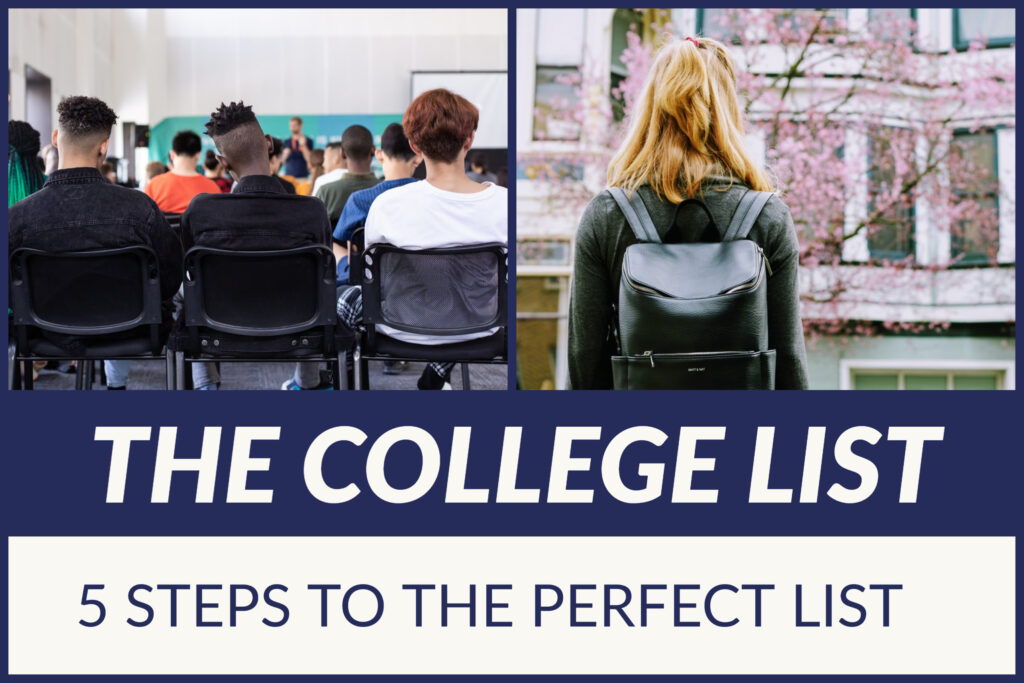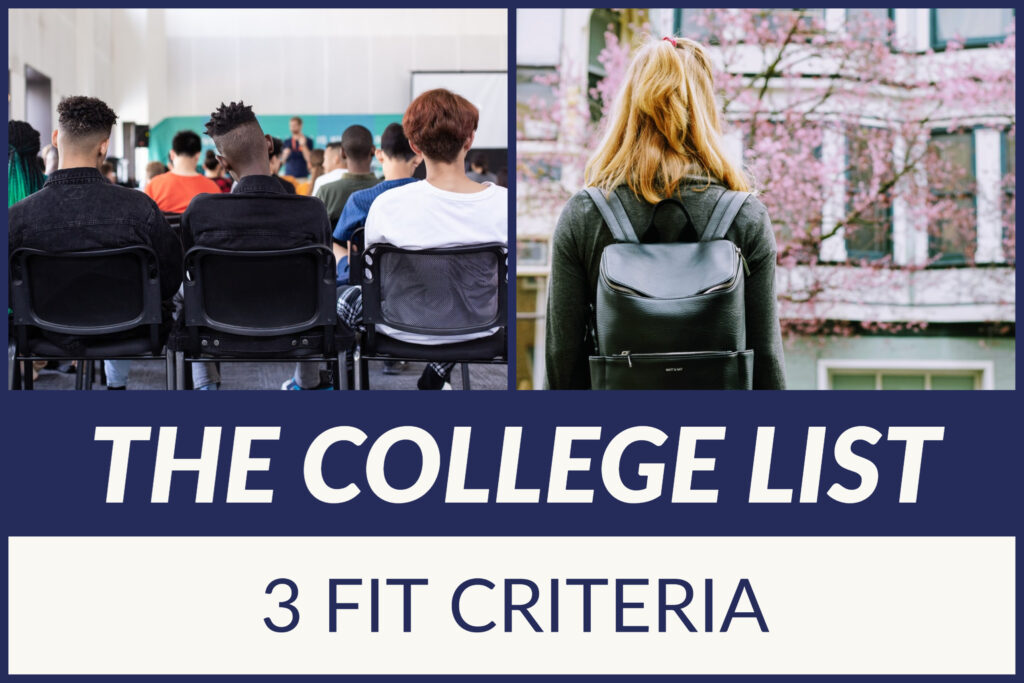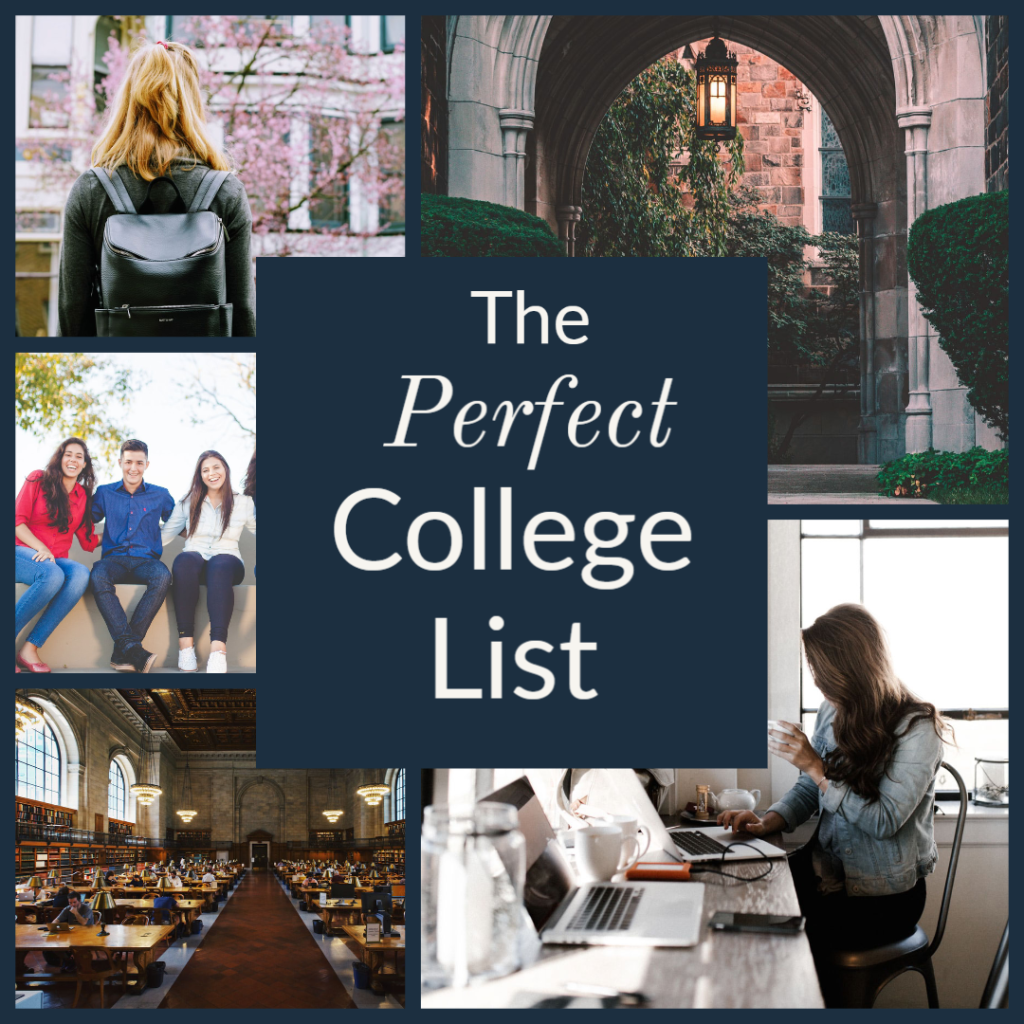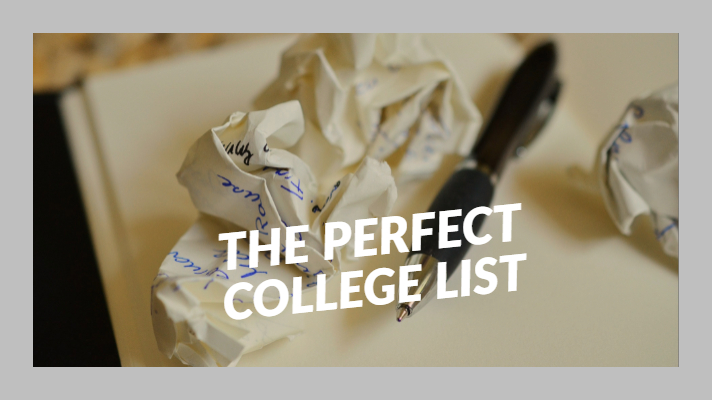US News, Forbes, USA Today, Princeton Review, and Niche are just a few of the many college rankings available for parents and students to review. Most college experts agree these college rankings should have little weight when choosing a college. But let’s get real for a moment, we all rank everything: from movies, to music, to restaurants, to hotels, to companies. Consumer reports ranks just about everything known to man: appliances, electronics, automobiles, and more. The New York Times Bestseller lists ranks books. Rankings are a part of our lives.
Continue reading Create Your Own College RankingsTag Archives: college list
How I Helped My Daughter With Her College List
With the school year in full swing, college-bound juniors are working on their college list. Narrowing down the college preferences can be difficult, especially when your student is indecisive or feels overwhelmed about the college process. These young students need guidance, even if they don’t think so or are hesitant to ask for help.
When my daughter started making her college list in her junior year she didn’t know where to begin. She had a few must haves on her list: sororities, a small college, and one with a focus on fashion merchandising. Beyond that, she knew she wanted to apply to a few colleges in Boston, especially the one on her dream list: Boston University. But in the beginning, it seemed like a monumental task.
Following are five steps we followed to begin and ultimately create her final college list:
Continue reading How I Helped My Daughter With Her College ListShould Your Student Apply to 40 Colleges?

I read a post from a parent on one of the Facebook groups I follow. Her son was applying to 40 colleges and she asked how he was going to do it using the Common App since there is a maximum of 20 allowed in the application.
Parents chimed in with suggestions on how to supplement the Common App by applying via college websites and choosing alternate college applications. I read all the suggestions, which were logical and helpful. I kept wondering if anyone would respond by encouraging her to help her son narrow down his list.
Finally, someone spoke up with that suggestion. I’m hoping the mother took their advice because it was the most logical of all.
Continue reading Should Your Student Apply to 40 Colleges?The College List: 5 Steps to the Perfect List

Whether your student is a freshman or entering the last semester of their junior year, you should be looking ahead towards graduation. The first, and obvious question, should be—what’s next? What will your student do after high school? Will they enter the job market, take a gap year off to decide, enter the military, or will college be their next step?
If college is in their future, the college list should be a priority. All decisions, goals and pursuits will be geared toward receiving an offer of admission from those colleges on that list. Those colleges should be chosen with much thought and planning. Your student’s goal is to first be offered admission, and secondly be awarded aid that will pay for the education.
In order to craft a great college list, you and your student must keep an open mind. With over 4000 institutions of higher learning in this country alone, the obvious choices are not necessarily the best ones. Before you haphazardly throw some names onto the list, follow these simple steps:
Step 1: Look at the statistics and rise to the top
The best college is the college that fits your student’s academic and social needs, and at the same time is affordable. The last thing you want is for your student to graduate with debt; and the best way to guarantee the most merit aid is to apply to a college where your student is at the top of the applicant pool. If your student’s grades, scores, and extracurriculars exceed those of the average applicant, a college will be more likely to entice him with merit aid (scholarships and grants).
How do you know where your student falls in the applicant pool? Use sites like College Navigator and College Data to compare your student with current students. Look at the figures for admitted students: what is the average test score, what is the average GPA, how much weight do they place on extracurriculars? If your student’s statistics are above these average amounts, the college will consider them a highly desirable applicant.
Step 2: Consider the unknowns
Most students gravitate toward the known colleges—those with national or state recognition. But there are so many excellent colleges within each state that go unnoticed. These are often smaller private colleges offering excellent liberal arts educations. These colleges have alumni that support them and often provide continued support—translating into scholarships and grants to new students. The larger state university may appear cheaper based on tuition, but the smaller private college will often award more merit aid to entice students.
I recommend parents encourage their students to look into the College That Change Lives . These colleges are built on the premise of “building the knowledge, character and values of young people by introducing them to a personalized and transformative collegiate experience.” Also consider technical colleges like Penn College that combine a liberal arts education with hands-on career training.
Here are some other links to research:
13 of the Most Unique Colleges in America
50 Most Underrated Colleges in America
50 Underrated Colleges Doing Great Things
Step 3: It’s all about the numbers
You might be surprised to know that in addition to all the factors students use to choose a college, there is one they might overlook: statistics. While location, major, campus appeal, and others are certainly important statistics will help you and your student make a more informed college choice.
Why statistics? Statistics will help you determine some of the key factors involved in choosing a college. With statistics you increase the odds of your student being accepted, receiving more financial aid, and graduating on time. You can also determine the class sizes, the freshman retention rate and the odds of finding a job after graduation.
Two good sources for college statistics are College Navigator and College Data. These two resources will help you make an informed college choice. Numbers aren’t everything, but consider these eight important stats when you and your student are looking at schools:
- Rankings (simply as a baseline for comparison)
- Financial aid percentages
- Acceptance rates
- Student-to-professor ratios
- Freshman retention rates
- Graduation rates
- Student indebtedness
- Percentage of student who are employed after graduation
Step 4: Let the money do the talking
There’s no point in adding a college to the list if it’s unaffordable. Your student will be disappointed if offered admission and the cost makes it impossible for them to attend. Before applying, research the financial aid footprint of every single college on the list. How much aid do they typically give? How much debt does the average student graduate with? Use their net price calculator and determine what it will cost to attend there before applying. If your student is offered admission, there will be no surprises and disappointment if you do your due diligence before the application process begins.
Colleges offering small percentages of financial aid in the form of scholarships and grants should only be considered if you can pay or your student makes applying to scholarships a priority. You can’t count on scholarships or grants, but your student can certainly do everything to position themselves at the top of the applicant pool to receive them.
Step 5: Do a side-by-side comparison
How do you compare colleges once you have a solid list? Your student should develop their own rankings based on their personal choices and priorities. These items might include the obvious items like academics and location, to such unconventional items like Greek life and campus appearance. List all the items on a chart, giving each item a plus (+) or a minus (-) and tally up the scores. The colleges with the highest scores should make the final list. Colleges with lower scores might not make the list or need further evaluation.
By following these five steps, your student can create a strong college list of colleges that fit them academically, socially and financially. You might discover some hidden gems while navigating the search, just as my daughter did (and fell in love!).
The College List: 3 Fit Criteria

All the experts have advice on how many schools to apply to: some say 7, some say 10 and others say the more you apply to the better your chances. For me, the number isn’t as important as the content. A good college list needs to be well thought out and researched.
A good college list should have three “fit” criteria: financial fit, academic fit, and emotional fit. Once your student has a tentative list, ask if they have all three criteria before finalizing the list.
Financial Fit
Does the college fit into your family’s budget? If it doesn’t fit financially, cross it off the list. While you should never consider a college solely based on the sticker price, you should certainly examine what will happen if your student is accepted and doesn’t receive any financial aid. Remember when factoring in cost, don’t forget about the add-ons. They can add up and have a substantial effect on your budget.
Academic Fit
Does the college fit into your student’s academic aspirations? This might seem like a no-brainer, but the education is a key factor in attending college. Cross the college off the list if it doesn’t fit into your student’s academic learning style. For instance, is your student looking for smaller class sizes and strong relationships with his professors? A larger university won’t offer this.
Emotional fit
Can your student see himself attending college there? When he visited the campus, did it “feel” right and did he have a rapport with the students he came in contact with? You might think college shouldn’t be an emotional decision, but it is. After all, they will be spending at least four years of their lives there. If they don’t fit into the social climate they will be miserable.
Where does your student fit?
Another thing to consider is positioning. Is your student positioned well with the other applicants, especially if you are looking for merit aid. Are their scores, grades, and achievements good enough to put them at the top of the applicant pool?
As you can easily see, there’s more to refining a college list than picking a college with Greek life or college sports rankings. It’s a place your student will call home and he needs to feel comfortable there. Once you’ve determined if the college has all three criteria, add it to the list. It’s a keeper!
How To Create a Perfect College List from 5 Experts

With any project or goal, you look to the experts to help you reach success and achieve the goal. These five experts know all there is to know about creating the perfect college list.
What’s Critical in a College Admission Checklist
According to Lynn O’Shaughnessy of The College Solution Blog, using a college admission checklist is critical when your child is applying to colleges and universities.
Allowing a teenager to apply to any colleges without a solid game plan can be a financial and academic disaster.
There are five college check-list items that you and your child should accomplish before sending out applications. If you’ve already submitted your applications, you can definitely still do some of these tasks:
- Use Net-price calculators
- Check the generosity of individual colleges
- Apply for financial aid as soon as you can
- Consider including a mix of schools
- Check academic departments
What makes a good college fit?
Debbie Schwartz of Road2College.com offers parents advice from multiple college experts and points out with thousands of colleges and universities to choose from, finding the “perfect” school is a seemingly impossible task for any high school student and their parents.
Many college hopefuls have their eyes set on a particular dream school, while others may feel overwhelmed by endless options varying in size, location, reputation, and expense.
Applying to and gaining acceptance to colleges is daunting enough, let alone deciding where to attend in the fall.
So how exactly do you make the right decision?
Keep in mind that the true secret to college success is not necessarily attending the most selective or prestigious university.
It’s finding the right school for you where you can be your best self. And much like with dating or job-hunting, there is no one-size-fits-all college, but instead, a number of potential great picks for every individual student.
In this article, you can find the answers to these questions:
- Good Schools: Are They a Thing?
- What is a College Fit?
- How Do You Find the Right College?
Your College List: Researching the Academic Side
Katherine Price of Great College Advice, reminds parents and students that picking the final list can be a daunting task. One way to narrow things down a bit is to really look into the academic departments at the schools you are interested in. Since academics is one of the most important aspects of attending college, it is important that students feel connected to the curriculum and the major that they could potentially be studying.
When looking at college academics, consider these topics:
- Look at the curriculum
- Go beyond what majors are offered
- Get to know the faculty
- Research special programs and events
How Are You Conducting Your College Search?
Jeannie Borin or College Connections, reminds us that in conducting the college search, it is important to make sure a college list is well balanced with “reach,” “50/50” and “likely” colleges that fit the student’s profile academically and socially. Thorough research is necessary to be sure that students are applying to the right colleges for them. The research will also come in handy when completing applications and when answering essay questions that ask why an applicant wants to attend that college.
Here are some helpful tips that should help in your college search:
- Examine the campus life
- Explore academic programs
- Review college statistics
- Other factors to consider
Using Statistics to Find Your College Fit
I always recommend that parents and students take a close look at the college statistics.
You might be surprised to know that in addition to all the factors students use to choose a college, there is one they might overlook: statistics. While location, major, campus appeal, and others are certainly important statistics will help you and your student make a more informed college choice.
Why statistics? Statistics will help you determine some of the key factors involved in choosing a college. With statistics you increase the odds of your student being accepted, receiving more financial aid, and graduating on time. You can also determine the class sizes, the freshman retention rate and the odds of finding a job after graduation.
Numbers aren’t everything, but consider these eight important stats when you and your student are looking at schools:
- Rankings (simply as a baseline for comparison)
- Financial aid percentages
- Acceptance rates
- Student-to-professor ratios
- Freshman retention rates
- Graduation rates
- Student indebtedness
- Percentage of student who are employed after graduation
5 Steps to the Perfect College List

Whether your student is a freshman or entering the last semester of their junior year, you should be looking ahead towards graduation. The first, and obvious question, should be—what’s next? What will your student do after high school? Will they enter the job market, take a gap year off to decide, enter the military, or will college be their next step?
If college is in their future, the college list should be a priority. All decisions, goals and pursuits will be geared toward receiving an offer of admission from those colleges on that list. Those colleges should be chosen with much thought and planning. Your student’s goal is to first be offered admission, and secondly be awarded aid that will pay for the education.
In order to craft a great college list, you and your student must keep an open mind. With over 4000 institutions of higher learning in this country alone, the obvious choices are not necessarily the best ones. Before you haphazardly throw some names onto the list, follow these simple steps:
Step 1: Look at the statistics and rise to the top
The best college is the college that fits your student’s academic and social needs, and at the same time is affordable. The last thing you want is for your student to graduate with debt; and the best way to guarantee the most merit aid is to apply to a college where your student is at the top of the applicant pool. If your student’s grades, scores, and extracurriculars exceed those of the average applicant, a college will be more likely to entice him with merit aid (scholarships and grants).
How do you know where your student falls in the applicant pool? Use sites like College Navigator and College Data to compare your student with current students. Look at the figures for admitted students: what is the average test score, what is the average GPA, how much weight do they place on extracurriculars? If your student’s statistics are above these average amounts, the college will consider them a highly desirable applicant.
Step 2: Consider the unknowns
Most students gravitate toward the known colleges—those with national or state recognition. But there are so many excellent colleges within each state that go unnoticed. These are often smaller private colleges offering excellent liberal arts educations. These colleges have alumni that support them and often provide continued support—translating into scholarships and grants to new students. The larger state university may appear cheaper based on tuition, but the smaller private college will often award more merit aid to entice students.
I recommend parents encourage their students to look into the College That Change Lives . These colleges are built on the premise of “building the knowledge, character and values of young people by introducing them to a personalized and transformative collegiate experience.” Also consider technical colleges like Penn College that combine a liberal arts education with hands-on career training.
Here are some other links to research:
13 of the Most Unique Colleges in America
50 Most Underrated Colleges in America
50 Underrated Colleges Doing Great Things
Step 3: It’s all about the numbers
You might be surprised to know that in addition to all the factors students use to choose a college, there is one they might overlook: statistics. While location, major, campus appeal, and others are certainly important statistics will help you and your student make a more informed college choice.
Why statistics? Statistics will help you determine some of the key factors involved in choosing a college. With statistics you increase the odds of your student being accepted, receiving more financial aid, and graduating on time. You can also determine the class sizes, the freshman retention rate and the odds of finding a job after graduation.
Two good sources for college statistics are College Navigator and College Data. These two resources will help you make an informed college choice. Numbers aren’t everything, but consider these eight important stats when you and your student are looking at schools:
- Rankings (simply as a baseline for comparison)
- Financial aid percentages
- Acceptance rates
- Student-to-professor ratios
- Freshman retention rates
- Graduation rates
- Student indebtedness
- Percentage of student who are employed after graduation
Step 4: Let the money do the talking
There’s no point in adding a college to the list if it’s unaffordable. Your student will be disappointed if offered admission and the cost makes it impossible for them to attend. Before applying, research the financial aid footprint of every single college on the list. How much aid do they typically give? How much debt does the average student graduate with? Use their net price calculator and determine what it will cost to attend there before applying. If your student is offered admission, there will be no surprises and disappointment if you do your due diligence before the application process begins.
Colleges offering small percentages of financial aid in the form of scholarships and grants should only be considered if you can pay or your student makes applying to scholarships a priority. You can’t count on scholarships or grants, but your student can certainly do everything to position themselves at the top of the applicant pool to receive them.
Step 5: Do a side-by-side comparison
How do you compare colleges once you have a solid list? Your student should develop their own rankings based on their personal choices and priorities. These items might include the obvious items like academics and location, to such unconventional items like Greek life and campus appearance. List all the items on a chart, giving each item a plus (+) or a minus (-) and tally up the scores. The colleges with the highest scores should make the final list. Colleges with lower scores might not make the list or need further evaluation.
By following these five steps, your student can create a strong college list of colleges that fit them academically, socially and financially. You might discover some hidden gems while navigating the search, just as my daughter did (and fell in love!).
The Perfect College List

Did you know there are more than 4,000 four-year colleges and universities in the United States? That can make choosing a college overwhelming. But there is a college to fit your dreams – and finding it starts with the right list of schools where you plan to apply.
Your college list is the basis for every decision regarding college. Without a good list, it’s impossible to make a clearly logical and well-informed college choice. You should begin your college list during your junior year of high school. By the beginning of your senior year, you should have a final list for college applications.
The “Fit” Questions
How do you start a dream list? A good college list should have three “fit” criteria: financial fit, academic fit and emotional fit. Consider each school by asking these “fit” questions:
- Financial Fit-Does the college fit into your family’s budget?
- Academic Fit-Does the college fit into your academic aspirations?
- Emotional Fit-Can you see yourself attending college there?
Seven More Questions to Use as a Reality Check
Once you’ve answered the “fit” questions, dig deep and ask yourself these questions:
- Are you choosing a college to follow a boyfriend or girlfriend?
- Are you choosing a college to follow a best friend?
- Are you choosing a college because you follow the sports team?
- Are you choosing a college because it’s “fun”?
- Are you choosing a college because of location?
- Are you choosing a college because of its reputation?
- Are you choosing a college based on someone else’s opinion?
Divide Your College List Into These Categories
Once you’ve answered all those questions, you’re ready to begin your list, which should always include the Dream Team, the Best Bets and some Sure Things (also known as reach schools, best fit schools and safety schools).
The Dream Team
Your dream colleges should be a reach but not impossible. Those colleges have very low acceptance rates. I’m all for dreaming, but when it comes to a college list, practicality and logic reign.
The Best Bets
The colleges on this part of the list are colleges that would put you at the top of the applicant pool. It’s not all about the money, but money sure does make the final decision easier.
The Sure Things
Carefully consider the choices and make sure that these colleges are colleges you really want to attend. It will relieve pressure and stress if they offer you admission.
Consider This Important College Data
Now that you know which colleges to put on your college list, how do you choose the right ones? What criteria do you use to populate your list? Where do you find the best information, or statistics, to help you make your list?
Two good sources for college statistics are College Navigator and College Data. These two resources will help you make an informed college choice. Numbers aren’t everything, but consider these important stats when you are looking at schools
Rankings
Never rely solely on one set of rankings. Use the comparison tools to make a wise college choice.
Financial aid percentages
If you need financial aid, a college with a low percentage of merit aid should be eliminated from your list.
Acceptance rates
Look for colleges with high acceptance rates. Better yet, look for the colleges where you would be a top applicant in the applicant pool. This translates into more merit aid in the financial aid package.
Faculty-student ratio
If you’re looking at a big school, consider the size of the program that interests you. You may get more personalized attention in a major with fewer students.
Freshman retention rate
If schools you’re considering have a low freshman retention rate, there’s a reason. Some colleges do a great job of taking care of their freshmen; some don’t.
Graduation rate
When you research the college, look up their graduation rates. Low rates could be a red flag.
Average indebtedness
If the average student indebtedness is high, and you need financial aid, this college might not make the final list.
Percentage of students employed after graduation
Colleges with a high percentage of unemployed graduates should be avoided by students who need to incur high student loan debt.
Other Important Stuff to Think About
- Study styles: Are you more comfortable in a structured class or doing independent study?
- Money: Your budget plays a huge factor in the decision process.
- Size: Do you want small class sizes, or does it matter?
- Location: Do you want to go away to college or stay close by or even live at home?
- Extracurriculars: Are there activities that are crucial to having a positive college experience (for example, working on a campus newspaper, participating in intramural sports, studying abroad)?
- Academics: Is there a specific major you are interested in, or will a liberal arts degree do?
- Career focus: Do you need to consider a school that offers specialized degrees like culinary arts or fashion design?
- Sports: Does the school have a huge sports program, or do sports have little impact on your decision?
- Competitive or noncompetitive: Do you have the resume that will ensure acceptance to a competitive college like Stanford or Princeton?
- Specialized programs: Do you want to work in a specific field?
As you can easily see, there’s more to refining a college list than picking a college with Greek life or college sports rankings. It’s a place you will call home, and you need to feel comfortable there. Once you’ve determined that a college meets all your criteria, add it to the list. It’s a keeper!
For details on each category and more information on how to populate your college list, read the original article written for TeenLife Magazine: How to Put Together a College List that Finds the Perfect Fit.
Cast a Wider College Net for Your College Choices
 Join a group of parents whose students are getting college admissions letters and you’re going to hear the same conversations. Some are elated, others are confused, and many are disappointed.
Join a group of parents whose students are getting college admissions letters and you’re going to hear the same conversations. Some are elated, others are confused, and many are disappointed.
I guarantee you that the elated parents have students who took the time to research the college and made sure they were at the top of the applicant pool when they applied. The confused and disappointed parents more than likely have students who applied to elite colleges with little hope of being offered admission or little hope of being able to afford it if their students were accepted.
It seems in today’s competitive college market, parents and students are often blinded by the hype. They fall for the false narrative that a student can’t be successful with a degree from an unknown college. They believe the lie that you can’t get a superior education from a small liberal arts college. They fall prey to the peer pressure from other parents who love to name drop and brag about where their student is applying.
Unfortunately, students suffer when their dreams are squashed by a college that only admits 10 percent or fewer of their applicants. In fact, elite colleges work hard to boost their rejection rates every year.
The good news is your student can avoid rejection by casting a wider college search net and considering other options when making your college choices.
Consider all types of colleges
Many students stick to the obvious in-state public universities. These universities are often large and have tens of thousands of applicants every year.
Seek a career, not a degree
Not every student is meant to pursue a degree at a traditional college or university. If your student is interested in pursuing a trade, consider researching technical and training schools.
Find your niche and exploit it
When creating a college list, search for specific degree paths that might be off the radar.
By widening your student’s search net and being more creative with the college list, his or her chances of receiving an affirmative answer instead of a rejection will increase tremendously.
For the details on how to pursue each category, you can read my original article on TeenLife Magazine here: Crafting the Perfect Application List.
10 Criteria to Narrow Down Your College List

There are over 4000 four-year colleges in the United States and another 1900 community colleges. Choosing a college can be overwhelming if you don’t narrow down the choices with this simple list of basic criteria. Once you’ve narrowed down the college list, you can get more selective and specific with your final choices.
Here is a list of 10 choice criteria to consider:
- Your study preferences—Are they more comfortable in a structured class or do you excel doing independent study? Do you require academic challenge or prefer in-class time with little or no additional study?
- Money—Your budget plays a huge factor in the decision process. If your budget is tight, will you consider student loans? And if so, will an expensive private university be worth the debt?
- Size—Do you want small class size or does it matter? Does being part of a large student body appeal to you or would they prefer a small college atmosphere?
- Location—Do you want to go away to college or stay close by so you can live at home? Are you looking for a cultural experience that a big city offers or a down home experience provided by a small town college?
- Extracurriculars—Are you set on joining a sorority or a fraternity? Are these offered at the colleges you are considering? Are there other activities that you feel are crucial to having a positive college experience (i.e. working on a campus newspaper, participating in intramural sports, studying abroad)?
- Academics—Is there a specific major you are interested in or will a liberal arts degree do? Not every university offers the same academic disciplines.
- Career focus—Do you want to study the culinary arts or fashion design? Consider a school that offers these types of specialized degrees.
- Sports—Does the school have a huge sports program or do sports play little impact in your decision?
- Competitive vs Non-competitive—Do you have the resume that will ensure acceptance in a competitive college like Stanford or Penn State? Or do you have a strong academic showing that would send you to the top of the list at a non-competitive college and qualify you for a full scholarship?
- Specialized programs—Do you want to work in the stock market? Does the school offer a trading room? What about internships, undergraduate research, service learning, and even specialized senior capstone projects (integrating and synthesizing what you have learned).
The college list should be loosely formed by the start of senior year. Juniors should be focusing on college visits and start working on their list. Seniors should review this list and once offers of admission arrive, use it to make the final choice.



